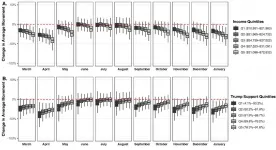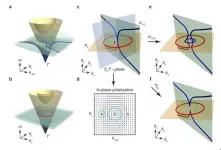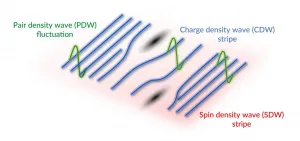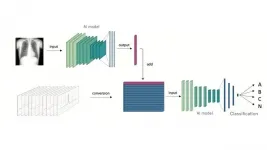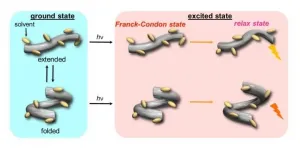(Press-News.org) Ann Arbor, April 22, 2021 - Using nearly a year of anonymous geolocation data from 15-17 million cell phone users in 3,037 United States counties, investigators have found that individuals with lower income per capita or greater Republican orientation were associated with significantly reduced social distancing throughout the study period from March 2020 through January 2021. Their findings are reported in the American Journal of Preventive Medicine, published by Elsevier.
The associations persisted after adjusting for a variety of county-level demographic and socioeconomic characteristics. Other county-level characteristics, such as the share of Black and Hispanic residents, were also associated with reduced distancing at various points during the study period.
"We started this project in April 2020 because we wanted to understand the social, economic, and political factors that drive people to engage in social distancing. We ended up tracking these factors for almost a year," explained lead investigator Nolan M. Kavanagh, MPH, Perelman School of Medicine, University of Pennsylvania, Philadelphia, PA, USA.
"A year is a long time to prepare policy responses and educate the public," he said. "Yet, the same kinds of communities that struggled to physically distance early on continue to struggle now."
To measure social distancing, the investigators used county-level averages of distance traveled per person using cell phone location data. They looked at the percentage change in average movement from the start of the pandemic relative to four pre-COVID-19 reference weeks. Statistical analysis was used to estimate the association between a variety of county-level demographic, socioeconomic, and political characteristics. Socioeconomic status was based on income per capita, and political orientation was based on the 2016 vote share for President Trump. Other county-level characteristics examined included the percentage of males, Black and Hispanic residents; share of residents over age 65; share of foreign-born residents; share of the workforce in industries most affected by COVID-19, such as retail, transportation and health, educational and social services; and the share of rural residential plots. These county-level characteristics were chosen based on their expected contribution to a community's ability to physically distance.
Investigators found a sharp reduction in average movement among US counties at the start of the COVID-19 pandemic and declaration of a national emergency in March 2020. Social distancing was greatest from late March to early June and then returned to baseline levels by June 2020. Distancing began to increase again in early September. However, even as a national trend evolved, the investigators found substantial variability in social distancing across counties.
While the share of racial and ethnic minorities, immigration, rurality, and employment in transportation were correlated with changes in average movement on many days, the single most consistent predictor of engagement in distancing across the study was higher per capita income. The single most consistent predictor of lack of engagement with distancing across the study was share of vote for President Trump.
Other county level-characteristics varied over time in their degree of association with physical distancing. During the early months of the study, counties with greater shares of Black and Hispanic residents were less likely to engage in social distancing. These adjusted racial and ethnic differences closed during the summer months before re-emerging in the fall. Similarly, rural counties were less likely to engage in distancing early on; by the end of the summer, rurality became the strongest negative predictor of physical distancing.
The investigators suggest a number of barriers that may underlie these findings. For example, lower-income or gig jobs may be incompatible with working from home, and lower income households may not have the necessary liquidity to shop in bulk, requiring more trips for groceries and essential household items. They observe that partisanship has dramatically shaped the government and public response to COVID-19 in the US. These findings show that political differences have continued to shape social distancing behavior, months into the pandemic and extending beyond the 2020 general election. As a result, both low-income and Republican-leaning communities are at greater risk for COVID-19.
"These results suggest that policy responses to the pandemic have failed to level the playing field," said Mr. Kavanagh. "We have not addressed the challenges to physical distancing faced by low-income Americans, such as working from home. And messages by political and public health leaders have not reached populations who may have different beliefs about disease risk. Analyses such as this study that monitor disparities over time can help us target public health and economic interventions to the communities that need them the most."
INFORMATION:
Topological photonics has attracted a lot of attention recently. The application of topological band theory to photonics not only opens the door to novel devices, but also stimulates the exploration of new topological phases. In the photonic regime, symmetries that are unique to electromagnetic (EM) waves can intrinsically protect the band degeneracies in the momentum space. Topological systems realized using such symmetries are uniquely "photonic", having no counterparts in electronic or phononic systems.
Among various topological features in momentum space, nodal chain is a special ...
Guilt and social pressure lead people to underreport COVID-19 protocol violations, according to study of experimental data across 12 countries.
Article Title: A guilt-free strategy increases self-reported non-compliance with COVID-19 preventive measures: Experimental evidence from 12 countries
Funding: J.-F. Daoust acknowledges the financial support from SSPS Open Access (University of Edinburgh). M. Foucault and S. Brouard acknowledge the financial support from ANR - REPEAT grant (Special COVID-19), CNRS, Fondation de l'innovation politique, as well as regions Nouvelle-Aquitaine and Occitanie. Richard Nadeau and Éric Bélanger acknowledge the financial support from the Social Sciences and Humanities Research Council (SSHRC/CRSH). M. Becher gratefully acknowledges ...
Unconventional superconductors contain a number of exotic phases of matter that are thought to play a role, for better or worse, in their ability to conduct electricity with 100% efficiency at much higher temperatures than scientists had thought possible - although still far short of the temperatures that would allow their wide deployment in perfectly efficient power lines, maglev trains and so on.
Now scientists at the Department of Energy's SLAC National Accelerator Laboratory have glimpsed the signature of one of those phases, known as pair-density waves or PDW, and confirmed that it's intertwined with another phase known as charge density wave (CDW) stripes - wavelike patterns of higher and lower ...
Substantial proportions of pregnant and postpartum women scored high for symptoms of anxiety, depression, loneliness and post-traumatic stress in relation to COVID-19 in a survey carried out in May and June 2020, according to a new study published this week in the open-access journal PLOS ONE by Karestan Koenen and Archana Basu of Harvard T.H. Chan School of Public Health, US, and colleagues.
Pregnant and postpartum women face unique challenges during the COVID-19 pandemic that may put them at elevated risk of mental health problems. These include concerns about ...
Time seems to pass more slowly in the UK COVID-19 lockdown - especially for people who are depressed, shielding or dissatisfied with social interactions
INFORMATION:
Article Title: Distortions to the passage of time during England's second national lockdown: A role for depression
Funding: The author received no specific funding for this work.
Competing Interests: The authors have declared that no competing interests exist.
Article URL: https://journals.plos.org/plosone/article?id=10.1371/journal.pone.0250412
...
Survey of 3,536 healthcare workers suggests 67 percent are suffering burnout, but people who receive frequent COVID-19 tests are less likely to be burned out.
INFORMATION:
Article Title: Determinants of burnout and other aspects of psychological well-being in healthcare workers during the Covid-19 pandemic: A multinational cross-sectional study
Funding: JK has received an educational grant from Johnson and Johnson.
Competing Interests: JK has received an educational grant from Johnson and Johnson. This does not alter our adherence to PLOS ONE ...
Kobe University Hospital's Dr. NISHIMORI Makoto and Project Assistant Professor KIUCHI Kunihiko et al. (of the Division of Cardiovascular Medicine, Department of Internal Medicine) have developed an AI that uses multiple kinds of test data to predict the location of surplus pathways in the heart called 'accessory pathways', which cause the heart to beat irregularly. In this study, the researchers were able to improve diagnosis accuracy by having the AI learn from two completely different types of test results- electrocardiography (ECG) data and X-ray images. It is hoped that this methodology can be applied to other disorders based upon the successful results of this research.
These ...
Stimulus-responsive supramolecular structures have emerged as an alternative to conventional ones, owing to their applications in sensing, drug delivery, and switchable memory systems. Now, scientists at Tokyo Institute of Technology explore the hydrostatic-pressure response of "foldamers"--artificial molecules that mimic protein folding--and report a shift in their preferred conformation with changing pressure, demonstrating hydrostatic pressure-enabled dynamic control. The finding opens doors to future development of pressure-sensitive foldamers and artificial materials.
Most, if not all, biological systems are extremely complex and often rely on interactions traditional ...
Animals use their sense of smell to navigate the world--to find food, sniff out mates and smell danger. But when a hungry animal smells food and a member of the opposite sex at the same time, what makes dinner the more attractive option? Exactly what is it about the odor of food that says, "Choose me?"
Research by investigators at Harvard Medical School illuminates the neurobiology that underlies food attraction and how hungry mice choose to pay attention to one object in their environment over another.
In their study, published March 3 in Nature, Stephen Liberles and co-author Nao Horio, identified the pathway that promotes attraction ...
STUDY SHOWS VACCINES MAY PROTECT AGAINST NEW COVID-19 STRAINS ... AND MAYBE THE COMMON COLD
A new study by Johns Hopkins Medicine researchers provides evidence that CD4+ T lymphocytes -- immune system cells also known as helper T cells -- produced by people who have received either of the two messenger RNA (mRNA) vaccines for COVID-19 caused by the original SARS-CoV-2 strain also will recognize the mutant variants of the coronavirus that are rapidly becoming the dominant types worldwide.
The researchers say this suggests that T cell responses elicited or enhanced by the vaccines should be able to control the current ...
